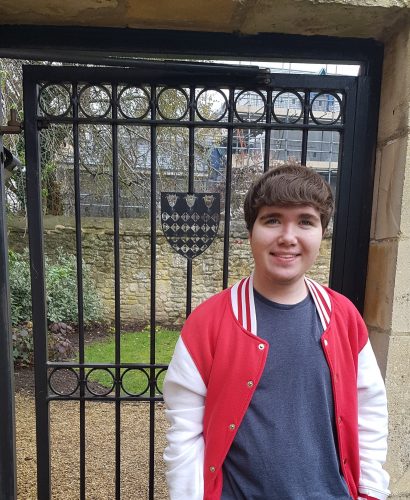Alumni
In the next installment of our No Two Journeys series, Alumni Leadership Board member Jouja talks to alum Daniel about how disability can affect social mobility.
There’s an irony to the fact that while mobility may be in the phrase “social mobility”, the recognition of the additional barriers that those with physical impairments face in pursuing social mobility is rarely recognised. In fact, disability in general – a physical or mental impairment that can be either visible or invisible but limits a person’s activities – is important to include in our understanding of social mobility. While socio-economic status and disability often sit side by side in sentences on equality and inclusion, the interaction between the two has been seldom explored.
8% of young people in the UK are living with a disability. The most common disabilities are social and behavioural (33%), learning disability (31%) and stamina, breathing and fatigue (31%). Class and disability are directly related – the average income of families with disabled children is 23.5% below the UK mean income. Why is this the case?
The relationship between class and disability is two-fold. Children who have experienced socio-economic disadvantage have an increased likelihood of developing a disabling health condition. At the same time, the presence of a disability in a household can increase the likelihood that they fall into a low socio-economic bracket. This is because a person living with a disability is likely to face an average of £583 additional costs per month than someone living without a disability. Arguably, understandings of poverty based on household size and income neglect to consider the extra costs that result from disability.
Clearly, having low socio-economic status and a disability can lead to a double disadvantage when it comes to social mobility. However, it doesn’t end there. Other factors are also at play. For example, if you’re also from a single-parent household, the risk of poverty for your family is 12 percentage points higher than a family without disabled children, and 4 percentage points higher than a two parent family with disabled children. While this article focuses on what it is like as a young person with a disability to navigate social mobility, it is important to note that having adults with disabilities in a household also acts as a multiplier effect on barriers to social mobility.
—-
Daniel, a first-year undergraduate reading History & Politics at the University of Oxford and a Sutton Trust Summer School alum, has first-hand experience of navigating higher education while living with a disability. He was diagnosed with fibromyalgia – a long-term musculoskeletal condition that causes pain all over the body – during his A-Levels. “I’d suffered with pain in my left arm that doctors originally thought was strain from revision”, says Daniel. “It was a major concern for me because as a student studying an essay based subject not being able to write very much could mean I wouldn’t be able to go to university at all”.
Fibryomyalgia can affect up to 1 in 20 people, however it has historically been a difficult condition to diagnose. It takes an average of three years from first symptoms to diagnosis. This process can often feel like “a marathon which is extremely arduous, tiring and time consuming”. Daniel, who was unfamiliar with the condition until he was diagnosed, said that he had to push his GP multiple times in order to get a diagnosis. “Once I was diagnosed, it felt like everything opened up”, says Daniel. “The medical letter changed everything. Beforehand, it was frustrating to go to universities and tell them I couldn’t physically write and they couldn’t do anything”.
There are many conditions like fibromyalgia that tend to be largely invisible and difficult to diagnose, including dyslexia, lupus and chronic fatigue syndrome. As many universities and other institutions require formal medical diagnosis to be able to make adjustments, this can negatively impact people who already have limited access to healthcare. People from low socio-economic backgrounds are less likely to have these conditions diagnosed because they can’t afford private healthcare. One university told Daniel to go down this route; “I can’t afford £800 to go private!” was his response. Other students have also found that the university paperwork requirements can prove to be very expensive.
While there are active debates on how the binary between disability and ability causes a simplified understanding of the spectrum of ability, Daniel’s story also sheds light on how we understand less-visible disabilities. “I try to avoid using the term disability. I recognise that it impacts people in much worse ways than me and I want to make sure the term is being used appropriately”, he said. Despite fibromyalgia meeting the conditions of disability under the Equality Act 2010, Daniel feels uncomfortable naming it as such. “When applying for internships and they ask if I have a disability, I’m not sure what to put”, he said. “It has definitely significantly impacted my ways of working, but my doctor didn’t class it as a disability on a form he gave me”. The confusion around what is classed as a disability can lead to many students missing out on important access opportunities.
Fibromyalgia, and other chronic fatigue conditions, can have a massive impact on education. Daniel’s inability to write because of pain in his left arm prevented him from being able to take exams without a laptop. Additionally, the brain fog and tiredness he feels presents an additional challenge to performing well in exams. Young people from disadvantaged backgrounds are already six times less likely to attend top UK universities. Having a disability can make it even harder. “Many students can go off track academically because they haven’t been given the proper support at A-Level”, says Daniel. There is clearly a need for more universities to reflect the effect a person’s disability has on their ability to perform in exams in their offer conditions.
Although there is still a long way to go, there are some important changes that are taking place. The number of new university students with disabilities has been increasing year on year and nationwide financial support including the Disabled Students’ Allowances (DSA), which are grants to help students with disabilities cover extra costs, are making attending university slightly more affordable. However, only 40% of students with disabilities are aware of this support.
While Daniel found his condition harder to manage during school – due to the less flexible timetables, high quantity of exams and the lack of knowledge his school had on how to support him – his university experience has been vastly different. Universities seem to be ahead of the curve compared to schools in terms of the support they offer for their students. Within 6 hours of him submitting his medical diagnosis, his university had already started putting assistance in place and creating a Student Support Plan with the help of a disability adviser. While many young people are concerned with questions of workload, accommodation or social life at university open days, for those with disabilities the way the university will make adjustments for them can be key to their decision. “I asked every university what they could do about my condition before I applied”, says Daniel. “There was one university that didn’t make my list because of how they reacted to my needs.”
For many from low socio-economic backgrounds or who are the first in their family to go to university, the prospect of the first few weeks of university life can be daunting. However, those with a disability have many additional hoops to jump through. Tasks that are expected as part of university life, such as using the library or writing essays, can be next to impossible for those with impairments to physical movement. Many feel like they have to adjust, rather than the university adjusting for them. For the most part, the assistance provided by Daniel’s university has been extremely valuable. They have provided him with a proxy borrower, suitable accommodation, and a flexible class schedule. “The university has been really proactive, putting in place adjustments I didn’t even realise I needed”, he says.
But social mobility isn’t just about education, it also concerns the workplace. Just 21 per cent of people with disabilities from working class backgrounds enter into higher paid occupations, compared to 43 per cent of people with disabilities from professional backgrounds. Even before he has entered the work-place full-time, Daniel’s condition has been a challenge for him in the workplace. “Retail jobs are the main source of income for most of my friends during school, and I just couldn’t do them”, he says. “I definitely earnt less money than some of my friends because of it”. Education and the workplace can’t be uncoupled when it comes to looking at class and disability as research has shown that having a university degree almost halves the disability job gap.
While there are improvements being made for access to higher education for students with disabilities, there is still a lack of recognition of how socio-economic status plays into this. Accessible accommodation is often more expensive, gaining medical letters can incur additional cost, and students studying degree apprenticeships or postgraduate degrees are less eligible for financial support.
It is not good enough for disability to be understood in a silo, it must be understood alongside other barriers to social mobility.
If you’re suffering from fibromyalgia or symptoms of fibromyalgia, you can find out more information here: https://ukfibromyalgia.com/ or http://www.fmauk.org/

